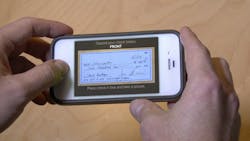It’s always a thrill to see the light come on in a service manager’s head when they start to understand what mobile technology can bring to their business — and what it can do for their own personal lives and peace of mind, for that matter. The wheels start to turn and they get more and more excited about the potential improvements mobility can offer their business. There are so many things that can be done, that it can also be a bit daunting.
That’s why I think it’s helpful to break down the capabilities of mobile field service management, or mobile field service automation, into consumable bite-sized pieces (workflows). Automating the job closeout and billing process through mobility is one of those bite-sized workflows and one that can have the greatest impact on the bottom line — an average of 27% in productivity gains.
Compare and contrast
Regardless of manual or automated field service operations, a service organization’s activities are, at a very high level, the same. The service professional receives the work orders, performs the actual services at the customer location, records notes, makes observations from the job, consumes inventory items, and makes future service recommendations. More advanced operations have field techs take pictures, record their time and they may require sign-off by the customer. The back office will update the customer record in the system, invoice the services, manage inventory and post the transactions to the company books.
With a strictly manual process, the service contractor takes notes or completes a checklist as part of the work order — typically hand-written in the field. That paperwork is taken back to the office. Once in the office, the dispatcher reviews and forwards to customer accounts for entry of the notes, parts used and future recommendations into the customer’s record; if pictures were e-mailed they can add those to the record.
The finance person will note the time taken on the job, any parts used, create an invoice and bill the job. At some point an office worker creates the work order close-out package to be sent to the customer typically along with the invoice. Whew, that is a lot of effort to report work performed to your customers!
With a mobile solution, all of the activities in the field can be integrated with back office systems, and the process can be completely automated. The notes taken, photo/video documentation and future recommendations are entered once on the mobile device and simultaneously added to the customer’s record in the back office. Generation of the close-out package is simple — photos taken, notes transcribed and items used are already in the system; the completed work order, with all supporting documentation, can be e-mailed automatically to the customer upon job completion.
The bottom line
The processes above are simplified, and every organization is different, but the benefits should be obvious. Mobility can:
- Improve accuracy: Nothing falls through the cracks. Every bit of time spent and parts used are billed. Handwriting isn’t left to interpretation and completed work orders can’t be lost or disappear.
- Increase efficiency: Steps are saved and work isn’t duplicated. Everything is entered once on the mobile device and simultaneously entered into back office systems.
- Increases revenue: Improvements in productivity mean that more jobs can be completed, and billed, in a day.
Could your business benefit from a 27% increase in productivity?
About the Author
Press Theriot
Vice President of Pre-Sales and Support
Press Theriot has more than 30 years of experience in technical services, ranging from pre-sales to technical support efforts. He leads the sales engineering, technical support, training and technical services organization at FieldAware. His teams handle customers in pre- and post-sales technical roles, including product technical questions, issues, education, training, user experience and implementation services. Prior to joining FieldAware in 2011, Theriot was senior director of Global Enablement at Websense. Prior to Websense, he was WW director of SE’s and consulting for McAfee for more than 13 years. Theriot holds a BBA/CIS from West Texas State University.
